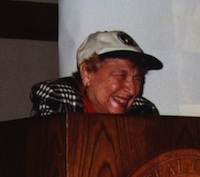 |
This is an archive of the 2001-2003 HACER website (many links still need to be updated). Here are more recent websites from 2008 and 2012. |
 |
| Rice University Hispanics of the 1940's and 1950's | |
|
by Robert Stanton
There were only a few other Hispanics in her graduating class of 1955, so Caram had to rely on her family support system for the strength and motivation to succeed in the highly competitive academic environment. But that was then. Today, Rice University is home to a diverse number of Latino students from around the globe, all committed to one predominant goal: being the best they can be in order to help others to succeed. Some of Rice's top Hispanic alumni returned to campus April 7, 2001 to honor the contributions of Hispanic students of the 1940s and 1950s (event flyer). Caram, along with Dr. Ninfa Cavazos -- Houston's first Hispanic female physician -- shared their experiences with the gathering of about 75 current and former students at the fete, sponsored by the Hispanic Association for Cultural Enrichment at Rice (HACER). "This event is important because it gives us a chance to share our history here, and also gives us a chance to meet some of the new students that are here," Caram said. "It's kind of a link from the past to the future. "It's very important that we be proud of our heritage and our association with Rice, and to show that we can make a difference by having come to Rice and being successful," Caram said. Indeed, if there were a theme for the history of Hispanics at Rice, it would be "Succeeding Despite the Odds." The chronicle would include alumni like Primitivo Niño, one of the first Hispanics to graduate from Rice in 1928. Like Caram and Cavazos, Niño found few, if any, Hispanics with whom to socialize during his tenure at Rice that began in 1923. So he lived off-campus and associated with the small but close-knit Mexican community in Houston. Despite his many obstacles, Niño studied mechanical engineering and was a member of the student chapter of the American Society of Mechanical Engineers. His legacy of quiet confidence and caring for his community continues even today. Niño's daughter, Cristina Cox, a '58 Rice graduate, and his grandson, Arthur Niño (class of '86) were on hand at the April 7 affair at the Ley Student Center. "There were only two other (Hispanic) graduates in 1958," recalls Cox, who holds a BA in Business Administration from Rice. "There were just so few of us. I don't think anybody considered a support group because we were just scattered here and there." But like her father, Cox succeeded despite the odds. She said she wishes he could have been alive to see her success. "I'm so glad to be here," she said. "I felt so bad because my father would have loved to see this. I'm glad that they (Rice administration) are recruiting minorities and giving us a chance to do this (event). There's a lot of talent out there that just needs to be found." Other notable attendees at the reception included Dr. Emilio Alberto Sarabia, a Houston dentist who attended Rice from 1952-54; Mary Alice Flores '55 now a retired nurse in New Orleans, and Mary Louise DeAnda, who attended Rice in 1948 but returned to graduate in 1973. Some alumni who were not able to attend included Florida resident Clifford Whitehill, a '54 alumnus who helped start the Hispanic Scholarship Fund; and Vancouver resident Enrique Hector Yramategui, a '44 alumnus and World War II veteran. Yramategui's brother, Manuel (class of '47) was the first director of Houston's Burke Baker Planetarium.
"It's very important because it's a unifying force," said Cavazos, who graduated in 1942. "It works on our connectiveness in that we can share our ideas, our sentiments, our fears and our emotions. It helps us look into the future because we get so much strength from looking into our past." Alberto I. Roca, Ph.D., a postdoctoral fellow in the Biochemistry Department who volunteers his time as an advisor to HACER, echoed Cavazos' sentiments. "This history project is trying to capture something that unfortunately, when these people pass away, is lost forever," Roca said. "It's our responsibility as young Hispanics to make sure that that history is remembered." Last October, a similar event honored Hispanics of the 1920s and 1930s. An archive of the history of Rice Hispanic students is available in the Woodson Research Center of the Fondren Library. The citation for this article is: R.Stanton, "Rice University Hispanics of the 1940's and 1950's" El Tecolote, September 2001 |
|
 Dr. Cavazos said the gathering was crucial because it illustrates the continuum between the past and the present, which is important in motivating young Rice students today.
Dr. Cavazos said the gathering was crucial because it illustrates the continuum between the past and the present, which is important in motivating young Rice students today.